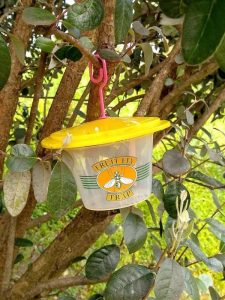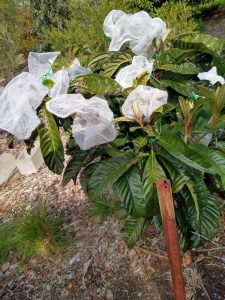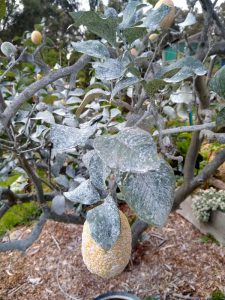Queensland fruit fly prevention strategies (Pam Jenkins)
Pam Jenkins, from Diamond Creek, discusses some Queensland fruit fly prevention strategies.
 I have had Queensland Fruit Fly (QFF) in my garden for the past 3 years. The first year was the worst and I have been working on minimising the damage ever since. Building on what I have learnt, the following is what I have done so far and plan to do this fruit season.
I have had Queensland Fruit Fly (QFF) in my garden for the past 3 years. The first year was the worst and I have been working on minimising the damage ever since. Building on what I have learnt, the following is what I have done so far and plan to do this fruit season.
To make it easier to cover and spray my fruit trees, over winter I reduced the height of all of them and thinned some of the branches from the espaliers. The feijoas and olives are still a bit big but they will be trimmed back later so that they fit under the nets.
The male QFF start flying at 20degC and will be congregating in warm green leafy areas, especially in warm microclimate areas in the garden. They are a tropical forest insect and love to gather towards the edge of dense leafy places, not necessarily host trees. At this time of year, look for them at about eye level on the north east side of your green bushy trees early in the morning before they warm up. They can start mating at 20degC so it is definitely time to act if you want to continue to have some fruit to harvest.
 I have hung male attracting pheromone traps at the edges of my garden to monitor any activity and set out some homemade protein/sugar traps close to, and in, host trees to attract young male and females that are emerging from their pupae as the weather warms. The immature male and female flies need protein and sugar to be able to mate and produce eggs.
I have hung male attracting pheromone traps at the edges of my garden to monitor any activity and set out some homemade protein/sugar traps close to, and in, host trees to attract young male and females that are emerging from their pupae as the weather warms. The immature male and female flies need protein and sugar to be able to mate and produce eggs.
 My loquat, the earliest of my fruit trees, has young fruit developing. I have reduced the number of bunches of fruit on the tree and placed white fruit bags over the rest.
My loquat, the earliest of my fruit trees, has young fruit developing. I have reduced the number of bunches of fruit on the tree and placed white fruit bags over the rest.
 The lemon and mandarin trees that are fruiting at the moment have been sprayed with ‘Surround’ – calcinated kaolin clay – which will serve to keep the gall wasp under control, help reduce evaporation from the wind and repel QFF as they really don’t like white. Caution! Don’t spray if your trees are in flower as it will impact the bees.
The lemon and mandarin trees that are fruiting at the moment have been sprayed with ‘Surround’ – calcinated kaolin clay – which will serve to keep the gall wasp under control, help reduce evaporation from the wind and repel QFF as they really don’t like white. Caution! Don’t spray if your trees are in flower as it will impact the bees.
 I have placed a white net over my mandarin tree and tied it firmly around the trunk. Fruit flies are low fliers and nets need to be secured either by weighting them to the ground or tying them firmly around the trunk or branch that you want to protect.
I have placed a white net over my mandarin tree and tied it firmly around the trunk. Fruit flies are low fliers and nets need to be secured either by weighting them to the ground or tying them firmly around the trunk or branch that you want to protect.
Placing nets and bags over fruit not long after it sets has been the most effective means of preventing damage to my fruit. Nets also keep the birds away but don’t stop the rats (which can chew through them). I have to keep checking. Anything exposed is likely to be eaten by some pest or other.
Don’t forget to cover your strawberries, tomatoes and other vegetables as they start developing fruit.
In November, I will spray the apple and pear trees with kaolin and cover the whole orchard area with white bird netting. Although the QFF can climb through the holes of the nets, I hope that they won’t be attracted to the area because there is so much white there. Last year I worried about pollination as my bees won’t go through the net to fertilise the raspberries but it appears that I have plenty of other pollinators and everything under the nets produced a normal amount of fruit.
As the fruit season progresses, I will be keeping any ground cover under the fruit trees low so that I can see and pick up any fruit that falls. The smell of rotting fruit will attract QFF, not to lay eggs in but as a source of protein and sugar for them to feed on. Any windfalls or unhealthy fruit picked from the trees can be frozen for a few days or thoroughly boiled. Boiling outside is best as the rotting fruit really stinks as it is cooking! After this, I either bury them or compost them in a container so that the flies can’t smell or access them. Otherwise, they can go out in the green bin.
The strategies above worked for me last year. I had very little damaged fruit and that was early in the season. I hope my experience will help you formulate your plan.

Great advice, appreciated.
Thank you, Pam. I didn’t have any fruit fly damage last season but now my cumquats are not edible and I hadn’t even seen the fruit fly.
I’d watched a webinar but hoped the little fliers wouldn’t come to Craigieburn but they’ve discovered my cumquat tree I think.
Thank you for explaining how to deal with the pests. Much appreciated.